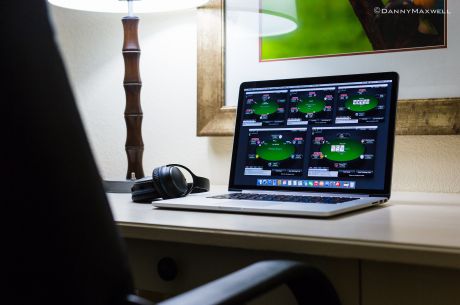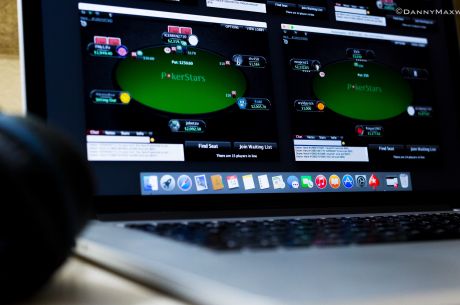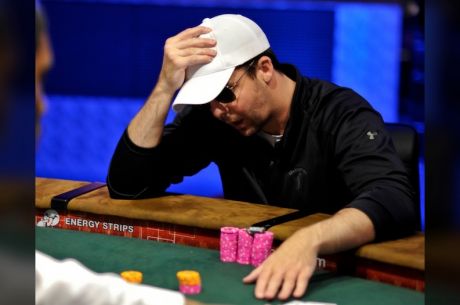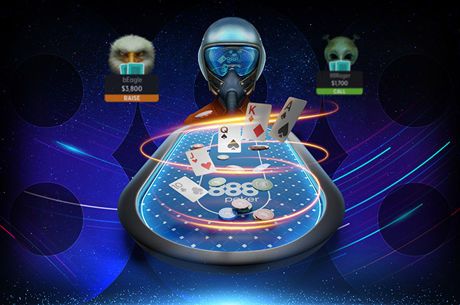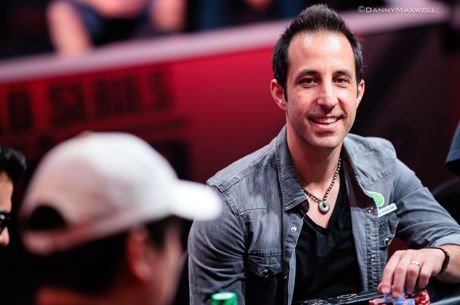Final Table Puzzles, Pt. 3: Pushing Pocket Tens, and Flopping a Flush
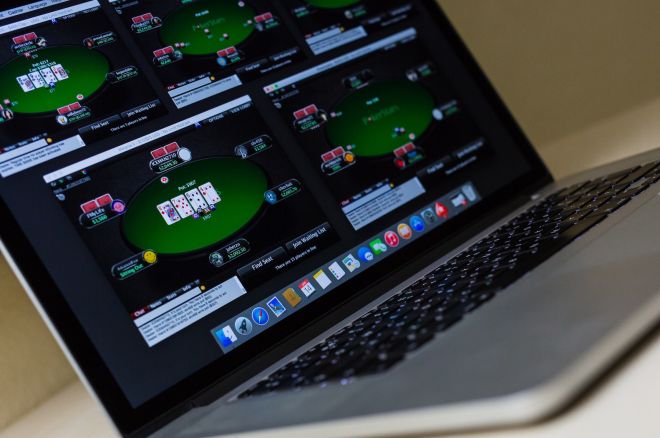
In this third and last part of Gareth Chantler’s “Final Table Puzzles,” he concludes his discussion of key hands from the final table of a $30 six-handed no-limit hold’em turbo on PokerStars.
Two more hands wrap up the tale of this final table.
Small or All?
Four-handed I was dealt pocket tens in the small blind. I had 64 big blinds, the big blind had 33, and the other two players each had 25. Remaining payouts were $2,205 (1st), $1,607 (2nd), $1,208 (3rd), and $840 (4th). When it folded around to me, I raised to three times the big blind.
I had been raising this large previously and a change of strategy now would be noticed. As the largest stack, I could pressure my opponents, particularly before the flop. By making larger raise sizes when out of position, I could limit their ability to enter comfortable situations after the flop, where they might find a strong enough equity advantage with which to stack off, or they could simply pot-control more effectively.
My opponent three-bet to exactly 7.5 big blinds. This was nearly one-quarter of the BB’s stack.
I think the case for calling here is quite slim. If our opponent is three-bet bluffing inadvisably, the player can connect with 9x7x- or Kx2x-type hands that would surrender 100% of the pot now if I four-bet. Actually it is easy to imagine tough flops for our 10x10x to navigate out of position no matter what my opponent’s range, should we call.
If we shove, we place a strong hand (pocket tens) in a shoving range that could include weaker hands like 2x2x and Ax6x-offsuit, giving these some protection.
Should and Could
My opponent shouldn’t be stacking off too lightly here. Some of the biggest pay jumps are in play right now, from fourth to third, and third to second. The theoretical utility of my opponent’s stack size is reaching three-handed after one of the two shorter stacks get KO’d. If the player is going to be busting fourth, it should be after this landscape of stack sizes shifts.
Let’s imagine my opponent is going with 7x7x+, AxJx here.
Shoving will get all the money in now, and prevent us from making a mistake. It also avoids being flat-called by AxJx / KxQx-type hands that might correctly take the price and thereafter play perfectly against us.
What about four-betting, say, the minimum to 12 big blinds total? My opponent could call the 4.5-BB price to try to win an over 20-BB pot and then be able to make decisions with the help of position regarding the 20 big blinds left behind. In fact I think this is how the player should be responding to a minimum four-bet strategy with the suited Broadway portion of a range that doesn’t include AxKx.
Four-betting small is essentially inviting our opponent to make a mistake the player might not otherwise make, but if the player is canny, it might allow my opponent to make money that might not otherwise have been made. And the stacks are discouraging for inducing a light five-bet here because to raise I have to make it at least 12 big blinds, which is 36% of the effective stacks. Surely I will look priced in.
As it happens I made it even more than 12 big blinds — I made it nearly 14. My opponent shoved Ax10x-suited instantly, I called, and I continued to run very well.
I think Ax10x-suited is in fact a classic hand that could just call the four-bet and decide. Granted it is easier to call 12 than nearly 14. It is also easier to imagine I am four-bet-folding, all other things equal, if I make it 12, though this player might not have seen it that way. I made an exploitative play and it worked out, but in hindsight it sure looks like I was simply fortunate.
Nowhere to Hide
Let’s fast forward to heads-up.
I thought my opponent had an advantage over me. At the least, the player had been getting the better of me to that point. When we were three-handed with a weaker player, I was leveraging my eventual heads-up foe out of pots using my chip lead. But now that it was just the two of us, my opponent was newly emboldened and I had nowhere to hide.
From the outset my button limping strategy was punished with three big-blind raises and I faced two three-bets in the early going, surrendering both times.
My opponent also seemed to recognize board textures very well. The player had seen me bluff three streets with the bottom of my range once before, but was still content to surrender on board textures with which I was likely connecting.
Further Fortune
With 45 big blinds to my opponent’s 43, I limped with 9♦7♦ and again came the raise to 3 BBs. I called — with position, with 42 big blinds behind, and with hope, the last of which was answered with a A♦2♦4♦ flop.
My opponent checked, which is great news. I know I am getting called twice often here. Seldom three times probably, but hope springs eternal.
I bet 2 big blinds into 6.25 on the flop, was called, and the turn was a perfect 8♥. Check again. I bet 4 big blinds into 10.25, my opponent called, and the river was another Ax.
Now remember, I perceive my opponent to both be better than me and strong at deciphering board textures. How often would I have an ace preflop that limped the button and called a three big-blind raise? Not that often compared to non-ace hands, since I would re-reraise AxJx, AxQx, AxKx and perhaps some other AxXx hands, too. I would also probably be interested in playing pairs like 4x4x and 2x2x faster before the flop. Thus my ability to have trips or a full house is quite limited.
Bluffing Much?
I don’t think my opponent checks an ace on the flop too often, but when my opponent does, the player always checks and calls the turn. So when my opponent does check and call the turn, the player has an ace sometimes, if not often.
My opponent might have something like Ax3x with the three of diamonds. I am fairly confident the player would check the big blind with 5x4x or 3x2x, meaning non-AxXx hands in my opponent’s turn check-call range here look like Kx4x and JxJx.
Let’s look at my possible river bluffs after betting the turn. I can have any high, unpaired diamond, any unpaired gutshot 5xXx or 3xXx, and any turned open-ender like 7x6x, 7x5x, or 6x5x. That’s a lot of potential air on this river. I should crave, in my opponent’s view, being able to effectively bluff on this particular run out, because of how often I will reach the river without a hand that can win at showdown.
In theory when you are bluffing often, you should be betting large. The more often, the larger.
So I bet all the chips, a shade under 34 big blinds into an 18-big blind pot.
I wasn’t bluffing; I had a flush. But I think this is the best way to go with my value hands as well, particularly if I suspect my opponent is getting the better of me. I can win this tournament here and now. I know I am in a good spot. I don’t have confidence I will find better ones later versus someone playing me tough.
At the end of a long dwell in the tank I got called by two tens (no diamond), and it was nice to start Sunday with a $2,200 win.
Gareth Chantler is a professional poker player who encourages you to check out the interviews, videos, promotions, and strategy articles at the Full Tilt Blog.
Get all the latest PokerNews updates on your social media outlets. Follow us on Twitter and find us on both Facebook and Google+!

